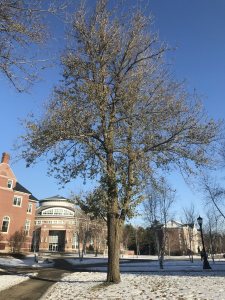Siberian Elm
Ulmus pumila | Family: Ulmaceae
Submission: Abby Hamilton ’21 and Emma Christman ’22
Leaves – Similar to U. alata, but singly serrate.
Twigs – Similar to U. americana, but slender and brittle; with conspicuous globose flower buds.
Fruit – Similar to U. americana.
Silvics – Native to Asia; hardest of all elms; ornamental; messy because of the brittle twigs; resistant to Dutch Elm Disease.
Natural History:
The Siberian elm is a non-native, deciduous tree usually planted as an ornamental in North America that can grow up to 70 feet in height. It has singly serrated, simple, and dark-green leaves that are 3-4” in length. The branching between leaves are alternate, and the branches are brittle, slender, and have a zig-zag appearance. The leaf buds are normally ¼” long and divergent from the branch, and the floral buds are large and round in shape. The bark is light-gray in color and consists of many irregular furrows. The fruit produced by the Siberian elm mature in the spring, and consist of ½-¾” winged samaras with deeply notched apexes. It generally has a messy appearance due to brittle branches.
In both the Midwest region and the Great Plains region of the United States, the Siberian elm has created a reputation for itself for invading pastures, stream banks, road-sides, and prairies. Because of its high tolerance to extreme conditions, such as droughts, exceptionally cold temperatures, and its ability to do well in locations polluted with city smoke and poor soil, the tree is able to grow abundantly in locations where other trees cannot. However, this ability to grow in these conditions has the potential to cause considerable harm to native vegetation. The Siberian elm is typically planted for windbreaks and lumber throughout the central US and ornamentals in the Northern US. An extremely hardy and fast-growing species, the tree is native to Asia and was introduced to the United States in the 1860s. It is most commonly found on dry sites as well as moist stream banks, in pastures, and grasslands. Although it does prefer well-drained and fertile soil in addition to full sun exposure, it can tolerate and thrive in many different conditions.
This particular species is resistant to Dutch Elm’s Disease and thus has grown in popularity in North America. Dutch Elm’s Disease is a fungus that arrives to the trees via the backs of two species of bark beetles. The beetles bury into the bark of the tree and lay their eggs. When the larvae hatch, they carry the fungus with them. After fungal infection occurs, the tree kills off a portion of itself to attempt to isolate the pathogen. Mortality can result as the tree tries to stop the spread of the fungus. Since the Siberian elm is non-native and appears to have resistance to the disease, it has been used to cross with the American elm (U. americana) in order to produce an American elm-appearing hybrid that is resistant to Dutch Elm’s Disease.
References:
Siberian Elm. c2019.Lisle, Illinois: The Morton Arboretum; [accessed 11 Nov 2019]. https://www.mortonarb.org/trees-plants/tree-plant-descriptions/siberian-elm-not-recommended
Weed of the Week: Siberian Elm. 14 April 2015. Newton Square, Pennsylvania: USDA Forest Service;[accessed 11 Nov 2019]. https://www.invasive.org/weedcd/pdfs/wow/siberian-elm.pdf
